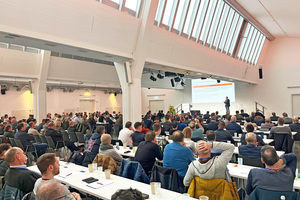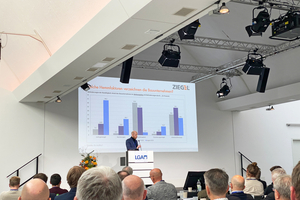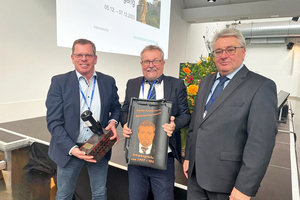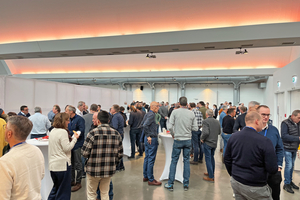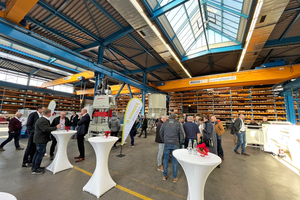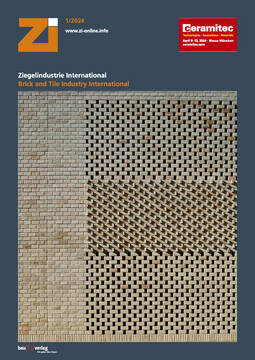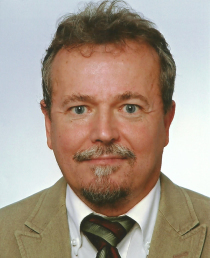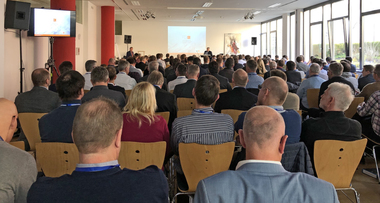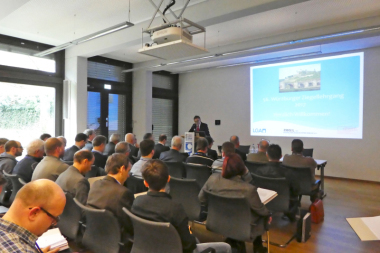An anniversary and a farewell - the 60th Würzburg brick-making course
Last December, a special brick-making course was held in Würzburg for two reasons. Not only was it the 60th anniversary of perhaps the most important industry event in 2023. In addition to this anniversary, it was also necessary to bid farewell to the long-standing head of the course, Joachim Deppisch from LGA Bautechnik. The interest of the participants is unbroken, as the new registration record of over 240 proves. As in the previous year, the course therefore took place in the spacious premises of the Vogel Convention Centre in Würzburg.
Programme on Tuesday, 5 December 2023
The course was opened by Johannes Edmüller, President of the Bavarian Brick and Tile Industry Association, and Joachim Deppisch. After welcoming the participants, Edmüller addressed the current situation in the industry. The situation is characterised by the construction crisis and falling figures in residential construction. According to Edmüller, it is now particularly important to promote owner-occupied homes in order to revitalise housing construction and the brick industry.
Joachim Deppisch opened the brick course for the last time with a moving presentation. He told how he was practically handed the job 25 years ago, recalled special moments from his work on the course and introduced his successor Andreas Klarmann. Two members of the programme advisory board, Ralf Borrmann and Eckhard Rimpel, took to the stage and thanked Deppisch on behalf of the board for his commitment. As a farewell gift, they presented him with a good bottle of wine, a matching fired ceramic wine bottle holder, a so-called wine stone, and a personalised memorial roof tile. The participants bid farewell to the visibly moved Deppisch with a long round of applause.
Attila Gerhäuser, Managing Director of the Federal Association of the German Brick and Tile Industry (BVZI), addressed the current challenges facing the brick and tile industry in his presentation. The current situation is characterised by declining demand, production plant shutdowns and efforts to extend the short-time working allowance. Gerhäuser expressed the hope that there would soon be a turnaround in interest rates and that residential construction would regain momentum.
The specialist programme began after lunch with a presentation on gas supply in Germany. Dr Ludwig Möhring, from the Bundesverband Erdgas, Erdöl und Geoenergie e. V., explained the theory that the gas market has gone from a supply crisis to a price crisis. The low prices before 2020, which Möhring described as pre-crisis and pre-war prices, would not return. However, there is currently no alternative to gas. As climate-neutral H2 is in very short supply, he advocated the use of blue hydrogen (steam-reformed natural gas) and carbon capture storage as tools for transformation.
Katharina Armbrecht from the BVZi followed this discussion with an overview of current developments in environmental and energy policy. Among other things, she explained the consequences of the Energy Efficiency Act, which came into force on 18 November 2023. She also addressed the consequences of the new Industrial Emissions Directive and BREF Ceramics. She asked the brickmakers for feedback on the expected costs incurred in fulfilling BREF. The figures collected are to be incorporated into a study and the political work of the BVZI.
Dr Rigo Giese, Head of the Essen Institute for Brick and Tile Research (IZF), spoke about the challenges and feasibility of using hydrogen in the brick and tile industry. He discussed the „H2-Ziegel“ project in collaboration with Hagemeister. The evaluation of tests with clinker bricks, roof tiles and vertically perforated bricks showed that hydrogen posed no or no serious problems in terms of firing technology and product. The real hurdle is the economic provision of green hydrogen.
The presentation by Dr Jens Petzold, Head of the KI Ceramics Institute in Meissen, focused on practical experience with electric and hydrogen firing. Petzold built on his presentation from the previous year and presented the results of three years of test firings. Based on the current technical development, everything, including the availability and price of the possible energy sources hydrogen and electricity, speaks in favour of investing in an electric tunnel kiln.
The following two lectures were presented by employees of the Ibbenbüren-based company Keller HCW. In the first presentation, Rainer Hüsing, Head of Central Project Planning, reported on ways to achieve climate-neutral firing processes. In addition to measures to increase energy efficiency in the firing process, he discussed alternative process technology and energy sources for reducing CO2 emissions, such as brick firing with hydrogen and various options for producing hydrogen using electrolysis. (See Green Challenge article in this issue, p. 27).
In the second presentation, Area Sales Manager Lutz Jankowski explained what is behind the claim of the new Atlas plant of the British brick group Ibstock that it is „The world‘s first net zero brick factory“. In the second presentation, Area Sales Manager Lutz Jankowski explained what is behind the claim of the new Atlas plant of the British brick group Ibstock that it is „The world‘s first net zero brick factory“. 50 per cent of the emissions produced in the existing plant to date will be eliminated through higher thermal efficiency in combination with reduced process emissions. The remaining emissions are to be offset by emission reduction projects.
Michael Riebesecker, Consolinno Energy GmbH - Regensburg, concluded the lecture programme of the first day.He explained the three steps of the application, static analysis, sector and system dynamic analysis and the implementation of optimised processes and conditions, and presented application examples.
For the evening event, Joachim Deppisch invited the participants to a boat trip with dinner on the Main. The time until departure could be used to visit the Würzburg Christmas market. Once on the ship, there was little to see of the banks of the Main due to the evening hour. The atmosphere on board was all the better, the food tasty and the drinks drinkable. After the end of the boat round trip, some of the participants went on to visit the pubs in Würzburg.
Programme on Wednesday, 6 December 2023
Unsurprisingly, the rows in the auditorium were not as filled as on the day before when the second day‘s programme began at 9 a.m. Those who were absent missed an exciting lecture. EurGeol Dr Lutz Krakow, KRAKOW Rohstoffe GmbH in Göttingen, explained the basics of raw material classification and evaluation with a focus on the brick and tile industry. In addition to important properties such as grain classes, plasticity and consistency, he also discussed the chemical-mineralogical composition of brick clays.
In his second lecture, Dr Krakow addressed the geological causes of CO2 emissions from brick raw materials and possible solutions in front of a packed audience. Using practical examples, he explained how carbon entered the clay. If necessary, the use of completely weathered cover horizons is possible at a local/regional level. Supra-regionally, one solution would be to use primarily low-carbon raw materials. In addition to suitable clay raw materials from clay mining areas, clay mineral filter cakes from the natural stone industry could also be considered.
Integrated solutions for energy-efficient moulding were presented by Philipp Händle from Händle GmbH Maschinen und Anlagenbau in Mühlacker and Christof Müller from ZMB Braun in Friedrichshafen. They presented new solutions from both companies and explained the advantages and savings potential of the machines and systems on show.
Dominik Laignel, from Rotho Metall- und Elektro-werke GmbH & Co. KG in Neunkirchen, explained in his presentation why the combination of impact jet drying and heat pump is „the ideal combination for energy-efficient drying of roof tiles“. Impact jet drying, when the drying air is directed orthogonally to the orientation of the material to be dried, enables faster drying at lower temperatures and more even drying results on the mouldings. In combination with heat pumps, this results in high savings potential.
Lucas Briest from MFPA Weimar presented the results of studies on process-orientated microwave technology for brick production. The application of process-orientated microwave technology to accelerate the drying process of vertically perforated bricks and to fundamentally investigate the microwave firing of dried green bricks had been investigated experimentally. Microwave technology has proven to be a promising and environmentally friendly option in both process stages.
Christoph Hellmich, Managing Director of Hellmich GmbH & Co. KG in Kirchlengern, spoke about heat recovery from flue gases, reducing energy consumption and CO2 emissions through heat exchangers. He described the technical principles and how to implement them. In addition to explaining the heat exchanger, Hellmich also explained the possibility of utilising flue gas with low flue gas temperatures economically using plastic pipes.
After the lunch break, Eckhard Rimpel presented the results of the high-temperature storage research project. This involves a new transport system for more energy-efficient firing of brick products in the tunnel kiln. Rimpel discussed the selection and production of ceramic bearings for high operating temperatures and high tribological loads, the proof of function on a laboratory scale for evaluating and optimising the bearings, the energy evaluation of the new kiln technology and a concept for transferring the results to real systems.
Björn Bernsdorf from Refratechnik Ceramics GmbH in Melle explained how damage to the kiln car and repairs can be minimised. In addition to avoiding vibrations caused by car movements, the correct assembly of wheelsets, chassis and refractory system as well as the correct travelling and cleaning of the tunnel kiln cars are essential for the longevity of the refractory structure and ultimately the entire car. Finally, he emphasised the importance of regular maintenance, the consideration of thermal expansion and other factors for the service life of the tunnel kiln cars.
Claudia Istel, Zschimmer & Schwarz GmbH & Co KG - Lahnstein, brought news and further developments in digital printing and glazing technology to the conference hall in Würzburg. The presentation dealt with the development and establishment of digital printing with highly pigmented inks in the tile industry over the past 20 years and its transfer to the brick and tile industry. The product range for digital applications includes solvent-based inks, water-based inks, glues for digital application and digital glazing.
In her presentation, Kerstin Hohlfeld from the KI Keramik-Institut discussed efflorescence and discolouration on brickwork, their possible causes and ways to eliminate and prevent them. Among other things, she explained what is meant by efflorescence/discolouration, what causes it (already present in the brick/reaction with the environment), where it occurs, which measuring methods can be used to determine soluble components in the brick material and which tests are useful for discoloured brick areas.
Heiner Kruse M.Sc., Rheinland-Pfälzische Technische Universität Kaiserslautern-Landau, presented a simplified verification procedure for the classification of thermally insulating vertically perforated bricks in the event of fire. As part of his presentation, he explained how the proposal for this procedure was developed theoretically and experimentally. At a later date, table values for the categorisation of thermally insulating vertically perforated bricks into fire resistance classes for one-sided fire exposure will be available.
Dr Ralf Wagner from MFPA Weimar discussed the design of functional brick surfaces to influence the urban microclimate and building energy requirements. In urban areas, building components absorb short-wave solar radiation and radiate the thermal energy again, which leads to higher air temperatures. This effect could be reduced if the building components reflect more sunlight thanks to special optical properties. Wager presented the results of the spectral measurements carried out and explained the connection between reflection and the structuring or colour design of the surface.
The final speaker in the lecture programme was Alexander Winkel from the IZF, who spoke about the use of brick-containing crushed sand in Portland pozzolanic cements. He discussed the results of two research projects, including the correlation between the type of crushed sand, grinding energy and compressive strength, as well as the fact that there is a correlation between the colour of the crushed sand and its brick content, but not its pozzolanic activity.
Conclusion, excursion and outlook
At the end of the presentations, Deppisch thanked all participants for the successful course and said goodbye to many of them personally. One final item on the programme took place on Thursday, 7 December 2023 and for the first time since 2019: the excursion. The destination of the excursion was Händle GmbH Maschinen und Anlagenbau in Mühlacker, Baden-Württemberg.
Looking back, the organisers were very satisfied. The next Würzburg brick training course will take place from 3 to 5 December 2024.

